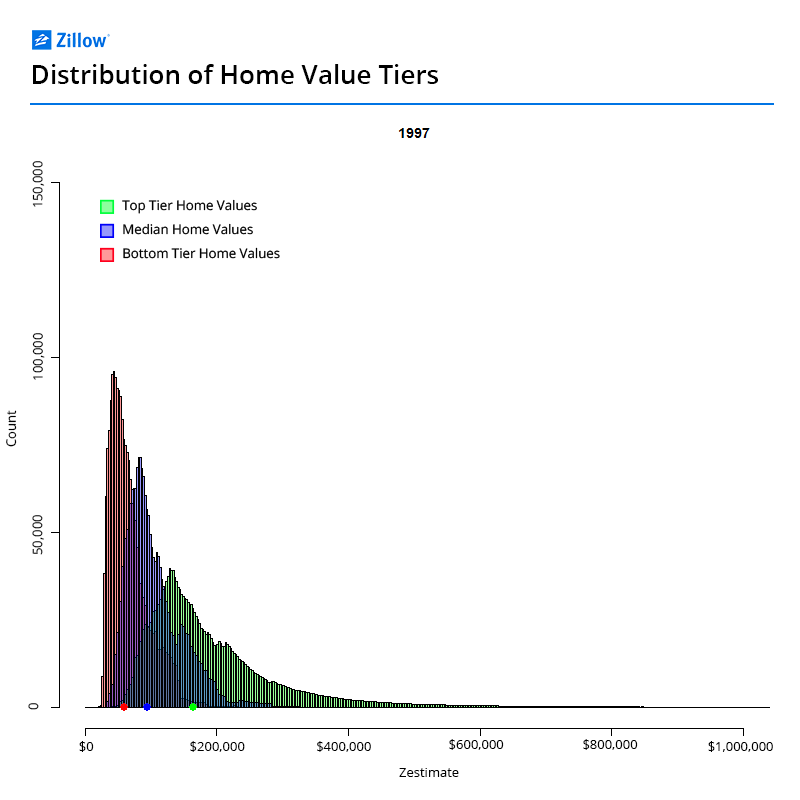Value Add: How the Gap Between the Bottom and Top of the Housing Market is Widening
The gulf between the housing haves and have-nots has widened considerably over the past two decades, as top-tier homes gained more value than less valuable, more entry-level homes and bottom tier homes in general lost more of their value during the housing bubble bust.
- In 1996, the median top-third home was worth 2.75 times more than the median bottom-third home. Today, typical top-third U.S. homes are worth more than 3.2 times as much as typical bottom-third homes.
- In January 2000, the average percent difference across all metros analyzed between the least expensive top-tier home and most expensive bottom-tier home was 66 percent. As of August, the difference had widened to 76 percent.
- A top-tier home in some markets is a bottom-tier home in others, and vice versa. In Atlanta, for example, homes in the top tier were worth $255,950 in August 2016. But most of these homes would be bottom-tier homes in the San Francisco metro, where any home valued less than $632,800 falls into the bottom one-third of all home values.
The gulf between the housing haves and have-nots has widened considerably over the past two decades, as top-tier homes gained more value than less valuable, more entry-level homes and bottom tier homes in general lost more of their value during the housing bubble bust.
In 1996, the median U.S. home valued in the bottom-third of all homes was worth almost $110,000 less than the median, top-third U.S. home ($62,400 for a median bottom-third home, $171,800 for a top-third home). Today, the dollar-value gap has more than doubled, to more than $236,000 (the median, bottom-third U.S. home was worth $106,200 in August; the median top-third home was worth $342,600). Put another way: In 1996, the median top-third home was worth 2.75 times more than the median bottom-third home. Today, typical top-third U.S. homes are worth more than 3.2 times as much as typical bottom-third homes. These changes in home values by tier mirrors changes in incomes over roughly the same period. In June 1999 the median top tier worker had an income of $88,000, 5.8 times greater than the median bottom tier worker ($15,200). 16 years later, the top tier worker made more than 6.6 times the bottom tier worker at $128,640 and $19,338 respectively.
The rate of change between wage growth for the highest earners and the lowest earners certainly drives growing inequality in the United States, but it is not the only contributor. The growing wealth gap is also significant, driven in no small part by changes in value of most people’s largest asset – their home. A homeowner that bought the typical U.S. bottom-third home in 1996 would have seen the value of their home increase by 70.2 percent if they still lived in that home today – not a bad investment, especially considering the wild up and down swings of the past ten years. But those able to buy a median top-third U.S. home in 1996 that are still in that home today would have seen the value of their investment essentially double, rising 99.4 percent between April 1996 and August 2016. Combined, these factors result in acute affordability concerns.
The red, blue and green dots on the horizontal axis in the plot below illustrate the movements of median U.S. home values by tier over the past 20 years, and the widening home value gap between the top and the bottom of the market.
 But looking beyond national medians and instead focusing on disparities between tiers in different metros reveals a more dramatic story. In the plot, each vertical line represents the median value of a bottom-third, median and top-third home in a given, individual metro. Over the past two decades, all three groupings have flattened out and widened to some extent as homes overall grew in value. But the extent to which the green, top-tier grouping both flattens and widens is a striking indication of just how much more expensive top-third homes have gotten in more metros than bottom-third and even median homes over the same period.
But looking beyond national medians and instead focusing on disparities between tiers in different metros reveals a more dramatic story. In the plot, each vertical line represents the median value of a bottom-third, median and top-third home in a given, individual metro. Over the past two decades, all three groupings have flattened out and widened to some extent as homes overall grew in value. But the extent to which the green, top-tier grouping both flattens and widens is a striking indication of just how much more expensive top-third homes have gotten in more metros than bottom-third and even median homes over the same period.
In January 2000, the average percent difference across all metros analyzed between the least expensive top-tier home and most expensive bottom-tier home was 66 percent. As of August, the difference had widened to 76 percent. Since 2000, the percentage gap between the same “expensive” bottom-tier home and “cheap” top-tier home has widened in 23 of the top 35 largest metro areas analyzed. As of August, the gulf between bottom-third values and top-third values was widest in Detroit (top-third homes are worth 127.3 percent more than bottom-third homes), St. Louis (98.4 percent) and Atlanta (97.5 percent). Not coincidentally, all three of those metros experienced high levels of foreclosure during the housing crisis – and foreclosures were far more prevalent among bottom-third homes, which were also likely to lose more value during the bust.
One final note: It’s hard not to notice the striking overlap between the groups in the plots above. A top-tier home in some markets is a bottom-tier home in others, and vice versa. In Atlanta, for example, homes in the top tier were worth $255,950 in August 2016. But most of these homes would be bottom-tier homes in the San Francisco metro, where any home valued less than $632,800 falls into the bottom one-third of all home values. The mobility implications for someone in Atlanta looking to sell their home and purchase a new home – not even necessarily a comparable home – in a more expensive market like San Francisco are apparent.

